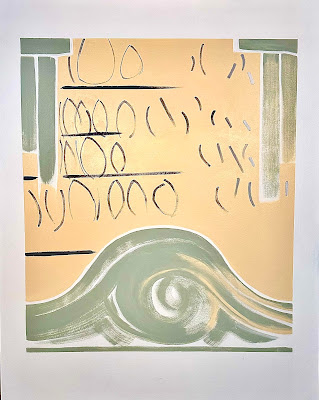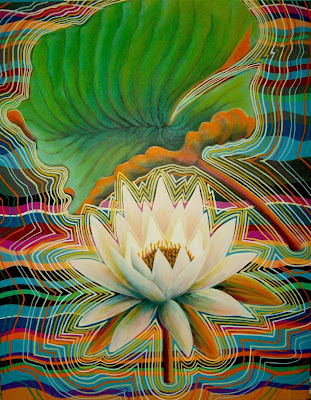Islands Of Grace: Restorative-Yin Yoga Journal
The quiet and stillness of restorative-yin poses offer islands of grace
RESTORATIVE-YIN YOGA involves supported body/mind relaxation. This is gentle, gentle yoga that promotes deep relaxation for stress reduction while also stretching and rehabilitating connective tissue.
Saturday, April 6, 2024
Vritti & Annica
Wednesday, January 26, 2022
Restorative-Yin Yoga Sequence, Parts 1--4
Restorative Yin Yoga Sequences, 12 Parts
I: Part 1, Parts 1--4
To get a sense of a Restorative-Yin Process: Not just poses but rather what one brings to the poses...A Sketch
Part 1, Poses 1-4 of 12
Slowly, with intent to hold poses comfortably vs. move fast, and make sure that there is no pain if you want flexibility gain. Pain for gain is more for stability and it is the heart of vinyasa flow and this is not vinyasa flow. When uncomfortable, always, always back off (not folding or stretching as far). Follow the body vs. force the body, gradually note little gains in bending and reaching as nerve bundles in muscles and facia release, and enjoy the little graces you find there. The yoga pose does not have to be static or frozen, allow the pose to open.
Flex gain requires muscle and fascia release. Muscles and ligaments have a beginning and end point of attachment and so they cannot stretch much more. Flexibility is controlled by nerves that restrict stretch, and when we try to stretch muscles, micro-nerve bundles fire and we feel discomfort. By going softly, nerve bundles are not triggered and do not fire. Overtime, we can bend with little or no discomfort. Such flexibility is not simply a flexible body. This approach can improve overall flow in the body, even in soft tissue such as the lymphatic system as well as improve brain and endocrine function that regulate body processes.
Restorative-yin is about flexibility, modifying neuro-endocrine chemistry that over repeated practice sessions can make us less reactive to stressors. Mechanically, selected poses bring particular attention to lower back/lumbar and pelvic girdle and shoulders/posture. Overall, be smarter than a human and stretch like a cat that knows how to not hurt itself; listen to the body.
Use cushions/blocks for support, soft mat (“pilates-like mat” or even thicker), music, fragrance, blankets for cover when it seems feasible for you. Support is not cheating. It is what you should do to be able to relax and become more flexible. Flexibility that can make you aspire to eventually look like a “knot” can become a problematic obsession. It is enough to improve flexibility that helps you function, so that a more realistic practice is one that helps improve everyday functionality. The goal here is more of an optimal health and a more comfortable path to get there.
Seated or lying down, perhaps with blankets:
First Excellence: centering and opening/expanding
Breath
perhaps bring attention to breath, just as it is. With slight open lips, sense cool breath entering and warm breath exiting. Notice freshness washing awareness. Follow the breath, as it is, rather than intentionally breath. Perhaps 20,000 breaths per day with little attention, bringing attention to the imminent breath. Perhaps a gatha--in breath: “freshness”; out-breath: “releasing.”
perhaps breathing into belly, into diaphragm, into chest, then exhaling from belly, then diaphragm, the chest
perhaps attend to the exhale, allowing the breath to completely empty. Now or soon, await the return of the breath in this space of “perfect;y peaceful pause.”
Perhaps note the reduction of breaths per minute from perhaps 15 to 6 or 4 breaths with no drop in percentage of oxidation.
Second Excellence: perhaps allow some intention for today’s practice to emerge rather than setting an intention. Allow this intention to occur now or later.
Balasana--On your knees and folding forward, a little of B.1 (knees together) and B.2 (knees split): breath into belly to massage now-compressed organs as well as support the back (noting with breath-in, a little more comfort than breath-out), soften shoulders; if not comfortable when folding forward, put head on double fists or a block, then reach arms out forward for a Virasana fold to stretch lats and gradually reach further as lats release
Counter: sit up in Virasana (still on knees), place hands on floor behind back with fingers facing toward body to stabilize elbows and bend spine inward; pull shoulders back to open chest then pulse shoulders into a hunch to open muscles in upper back, repeat a few times.
Kneeling Down Dog--come up to knees, lower chest toward mat and extend arms (if needed use block or cushion under upper chest above breasts for relaxing support that allows more gradual opening than forcing the pose); then change the pose slightly by stretching both extended arms out to one side angle and then shift to the other side angle to turn spine, repeat both sides.
Malasana--come up to a squat and press hands together in front and make spine erect; then reach both hands out on the floor in front while maintaining upright postion, and gradually move the hands into the floor between the feet stretching the spine further outward; then in an erect squat, turn right raised hand out to one side using left hand on floor for support, shift to turn other raised hand out to the other side, gently twisting the vertical spine, repeat slowly to stretch muscle on lower chest sides. If it is not comfortable to sink deeply enough to make spine vertically erect, then tilt chest forward and overtime as flex improves go for more verticality. If there are knee problems that seem to make this pose difficult, skip this pose for now.
OPTION HERE: Having completed malasana, you can flow into Uttanasana (standing forward fold). Note that the “utt” in standing and seated forward folds means ‘intense,’ and if you straighten your legs you will feel the intensity in your hamstrings in your back
Monday, November 22, 2021
Thursday, November 5, 2020
Wednesday, September 23, 2020
A Restorative-Yin Yoga Sequence Sampler
- Pose Followed By Counter-Pose: Poses are selected that tend to provide a pose that stretches the lumbar region and/or hips, followed by a pose that counters the lumbar stretch.
- Support: Blankets, blocks, bolsters and straps are utilized on most poses to relax muscles to relax and open the body and to concentrate on connective tissue.
- Longer Duration Of Pose: 3 minutes to 20 minutes allows for deep relaxation for healing restoration as well as stretching of connective tissue. Introductory Restorative-Yin sessions may utilize shorter durations to begin to familiarize participants with the practice and to experience more options. Restorative retreats may utilize rather lengthy durations to deepen relaxation, restoration and deep listening to body-mind-spirit.
- Brief Intermediary Poses: intermediary poses are used primarily for gradual transitions between primary poses, for relaxation, for massaging movements, and as points for experiences such as guided imagery.
- Inversions And Twists: Inversions and twists are typically integrated near the end of the session.
Thursday, July 30, 2020
Breath
One of great gifts from across Southeast Asia was attention to the breath. This attention goes back more than twenty centuries. The root meaning of the Chinese kanji 合 that accessed the Chi, ki, or prana--the life force that permeated everything--was breath. Of course as directly life-giving, breath is apparent. A few minutes of suppressing breath can cause death. And yet, for all its value, filling each moment with perhaps 20,000 breaths per day, our breath goes largely unnoticed.
It is unusual that attention to breath in various ways, either by following or by manipulating breath, became a gateway to transformation of consciousness, identity and inseparability. One of the strong names for this attention was ‘yoga.’
While yoga became a term that outspread to many actions both kind and brutal, its practice, even as a binding activity in militant discipline, was--for most of its existence--was largely seated stillness and breath. Not one of many poses, the pose or
**********
A Restorative-Yin Breath Sequence
In restorative yoga, poses are deeply relaxing. In restorative-yin yoga, poses are sequenced to add longer-held poses that are gentle and supported to primarily exercise lower back and shoulders.
Restorative-yin yoga begins by either sitting in stillness or supine, covered by blanket (with options for eye cover, hand cover/weights, fragrance, music). This sequence can be practiced in the restorative-yin poses that follow this in-tial breath sequence.
Following silent seated or supine pose, attention is directed to a breath sequence of
noticing breath as-it-is,
following the inflow and outflow (prana & apana) and allowing it to come to balance,
noticing and following the out-breath and allowing it to completely release, and
noticing the appearance of the ‘perfectly peaceful pause’ that develops at the end of the out-breath.
The emphasis is upon following the breath (as a preparation to follow the body in restorative-yin poses to follow, rather than forcing the poses or manipulating the breath). This breath sequence becomes a model to apply to the restorative-yin poses. The poses are to approached “islands of grace” that will utilize next to no intentional effort to allow each suggested pose to come to you.
In this breath sequence, a normal rate of 10 -15 breaths per minute is easily reduced to 6 or 4 breaths per minute with no discomfort and a normal oxygen percentage likely maintaining at a 98% level. The body-mind connection begins to change almost immediately (as if measured in EEG brainwaves) with the appearance of higher amplitude alpha waves, followed by a deeper alpha, and occasionally by deeper amplitude theta trains (although the breath sequence is not
exceedingly long enough to regularly anticipate their presence).
When reclining (the major choice of participants to date), this breath sequence resembles savasana that may be done at the end of the restorative-yin sequence (or a more popular choice by participants--viparita karani [legs up wall]. Savasana is akin to a Western body relaxation process that begins with tensing muscles in a various body regions such as a leg and then relaxing those muscles. Modern yoga has a tensing savasna ‘pose’ that I have offered to participants, but have never seen done in modern yoga classes--seegra savasana [stiff corpse].
During this breath sequence in restorative-yin yoga, three ‘Excellences of Yoga’ are opened: (1) Centering/grounding, coming to the mat, being supported by the Earth, (2) Allowing an intention for this practice to emerge from within vs. setting a goal, and (3) opening the niyama of santosha to allow this practice to value comfort with where we are at throughout the practice session.
With just this sequence of breath, you could stop right there, and you would have the very multitude of centuries’ enduring heart and promise of yoga. It is about this breath and the road that it opens far, far more than it is about becoming a Gumby figure. Ultimately, it is not about a ‘you’ at all.
Monday, March 16, 2020
Just Listen & Follow
When events feel down pressing, we want to work harder, exercise, push back.
It is a time to listen and to follow.
Gradually, an energy appears, a resilience, lightening and lifting.
Begin with the body, resting on the floor, on your back. feet on floor with knees bent.
Swaying, pulsing, following, not holding
close one leg over the other, perhaps ankle on knee for a time, then other leg; then cross knee on knee, swaying for a time, listening, feeling what is moving, never pushing--flowing, releasing











